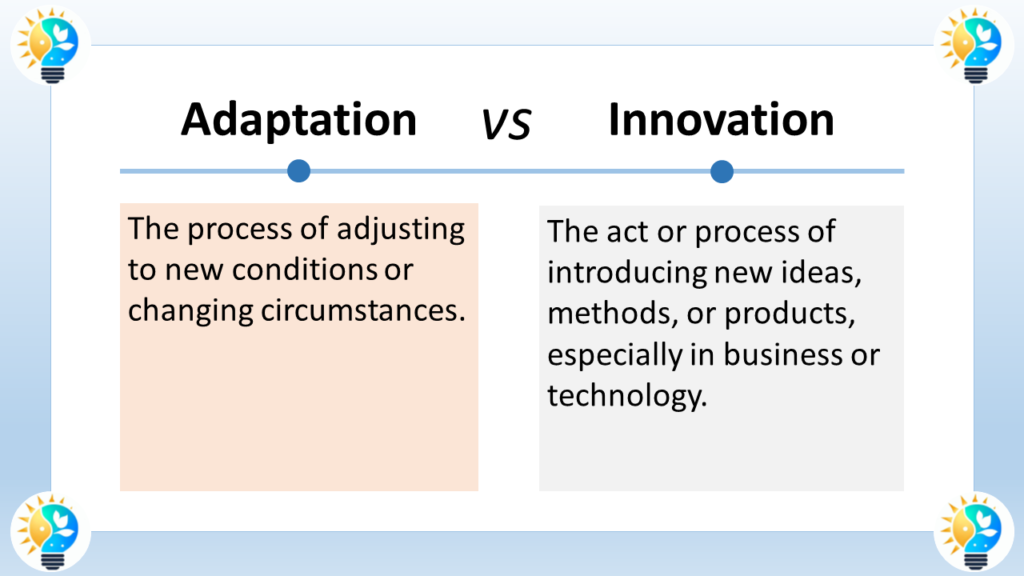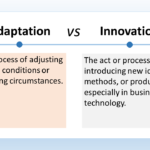The difference between adaptation and innovation lies in their respective approaches to change and development within various fields such as business, technology, and ecology.

Definition
Adaptation
Adaptation refers to the process of adjusting or modifying something to suit new conditions or environments.
- Characteristics of Adaptation:
- Reactive: Often a response to external changes or challenges.
- Modification: Involves altering existing structures, processes, or behaviors.
- Survival: Aimed at maintaining viability in a changing context.
Innovation
Innovation is the act of introducing something new, such as an idea, method, or device, that significantly alters or improves the status quo.
- Characteristics of Innovation:
- Proactive: Driven by the pursuit of new possibilities or opportunities.
- Novelty: Introduces unprecedented elements or concepts.
- Transformation: Leads to fundamental changes that can disrupt existing paradigms.
More Synonyms on innovation, innovate and innovative
Innovation Terms

Innovation is considered as a driving force in progress.
It includes the introduction of novel ideas, methods, or products that bring positive change and advancement.
For more information about innovations, check our glossary
Relationship and Relevance
While both adaptation and innovation involve change, they do so in different ways. Adaptation is about tweaking or refining what already exists to better fit new requirements or contexts. On the other hand, innovation is about breaking ground with something that did not exist before, creating change that can revolutionize an industry or practice.
The key difference between adaptation and innovation is:
Adaptation refers to adjusting or modifying existing solutions, processes, or systems to better fit a new context or environment. It involves making incremental improvements or changes to existing practices. Adaptation is often driven by necessity, such as responding to changing conditions or requirements.
Innovation, on the other hand, refers to creating something entirely new - a novel solution, product, or approach that has not existed before. Innovation is more proactive and visionary, driven by a desire to do things differently rather than just better. Innovators seek to challenge the status quo and develop transformative solutions.
In summary:
- Adaptation is evidence-based, focused on improving existing solutions, and has a lower failure rate.
- Innovation is voluntary, involves creating new and untested solutions, and has a higher failure rate but potentially greater impact.
- Adaptation occurs during times of conflict or change, while innovation happens more often during periods of stability and available resources.
- Adaptors prefer to work within established systems, while innovators seek to break the mold and find new ways of doing things.
The two approaches are complementary - organizations need both adaptive and innovative capabilities to thrive in changing environments. The most effective leaders and organizations are able to balance and leverage both adaptation and innovation as needed.
Context for Using Each Term
- Adaptation is used in situations where an existing entity or system needs to be adjusted to cope with new circumstances.
- Innovation is used when referring to the creation and implementation of entirely new ideas or products that change the way things are done.
Example of Utilization
A company that updates its software to be compatible with a new operating system is making an adaptation. If the same company develops an artificial intelligence platform that can predict consumer behavior, it is engaged in innovation.
In sum, adaptation is about adjusting to new conditions by modifying what is already there, whereas innovation is about creating something entirely new that has the potential to change the game. Both are critical for success and sustainability in a rapidly changing world, but they represent different approaches to change.
- Innovation vs. Adaptation
- Are You an Adaptive or Innovative Leader?
- Learning Adaptation
- Kirton's Adaptation-Innovation Theory
- Adaptation vs. Innovation: Which?
FAQ
Q1: Can adaptation lead to innovation?
A1: Yes, sometimes the process of adapting to new conditions can result in innovative solutions that go beyond mere adjustment.
Q2: Is innovation always better than adaptation?
A2: Not necessarily. In some situations, adapting existing systems may be more efficient or appropriate than creating entirely new solutions.
Q3: How do organizations balance adaptation and innovation?
A3: Successful organizations often employ both strategies, adapting to immediate changes while also investing in innovation for long-term success.
Q4: Can innovation occur without the need for adaptation?
A4: Yes, proactive innovation can create new opportunities or solutions without being directly triggered by environmental changes.
Q5: Are certain industries more focused on adaptation or innovation?
A5: While both are important across sectors, rapidly changing industries like technology often emphasize innovation, while more established industries might focus more on adaptation to market changes.

